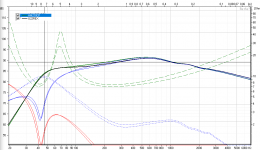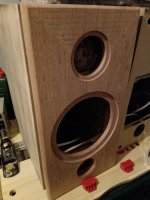Hi all,
I'm retrofitting/upgrading/rebuilding some speakers into existing 36L ported cabinets. I have a preference for rigid cones with proper pistonic motion and avoiding crossovers in the 300Hz-3kHz region. Rigid (metal) cones won't allow for this in an 8" woofer and I am limited to 8" woofers by the existing cabinet. I had pretty much concluded the only way to get what i want is to go 3 way, but this does complicate design and crossover significantly. (will be driven by 2 way active crossed amp, so i would have to passively cross the mid/tweeter if i went 3 way)
Then i found the Seas U22REX/P-SL, which professes super duper frequency response all the way to 4kHz, while (presumably) retaining a nice stiff woven cone. problem is is was custom designed by seas to be a lower mid in an open baffle Linkwitz design, very different to what i'm proposing and i'm wondering if it would even be suitable in a ported 2 way.
Does anyone have experience with this driver?
suggestions welcome 🙂
I'm retrofitting/upgrading/rebuilding some speakers into existing 36L ported cabinets. I have a preference for rigid cones with proper pistonic motion and avoiding crossovers in the 300Hz-3kHz region. Rigid (metal) cones won't allow for this in an 8" woofer and I am limited to 8" woofers by the existing cabinet. I had pretty much concluded the only way to get what i want is to go 3 way, but this does complicate design and crossover significantly. (will be driven by 2 way active crossed amp, so i would have to passively cross the mid/tweeter if i went 3 way)
Then i found the Seas U22REX/P-SL, which professes super duper frequency response all the way to 4kHz, while (presumably) retaining a nice stiff woven cone. problem is is was custom designed by seas to be a lower mid in an open baffle Linkwitz design, very different to what i'm proposing and i'm wondering if it would even be suitable in a ported 2 way.
Does anyone have experience with this driver?
suggestions welcome 🙂
I don't see why not!
Joachim Gerhard's original Arkadia, using a 8" CA22RNX paper cone by the look of it, and a 104mm SEAS 1" soft-dome, maybe a 27TFFC:
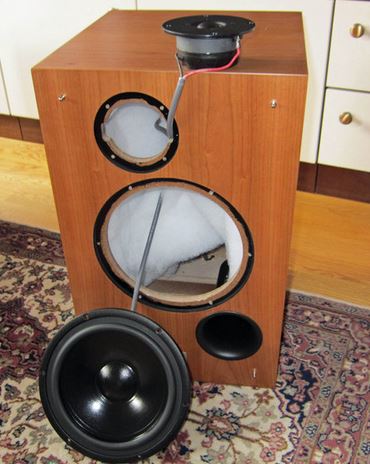
The Arkadia had quite a sophisticated crossover.
SEAS U22, a reflex driver for sure: H1659-08 U22REX/P-SL
SEAS DXT, a waveguide tweeter that is very likeable: H1499-06 27TBCD/GB-DXT
Joachim Gerhard likes this Arkadia upgrade on a simple capacitor to the tweeter. Maybe 4.7uF. No resistors needed, he says, but I'd have to think about tweeter polarity:
https://www.diyaudio.com/forums/multi-way/147632-classic-monitor-designs-45.html#post5143737
And he's no mug.
These sort of designs aren't terribly difficult, like SEAS Embla:
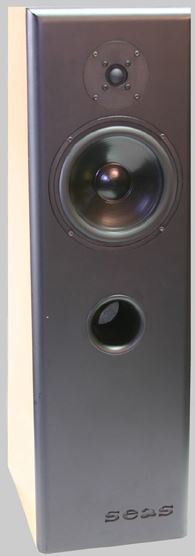
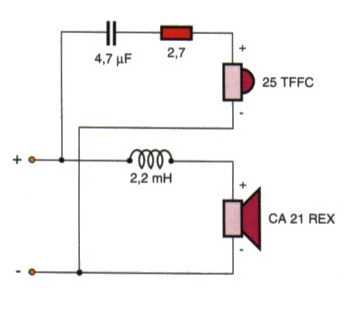
Of course, the World is your oyster with more sophisticated filters. Usually negative polarity 3kHz LR4 with an 8" bass.
Joachim Gerhard's original Arkadia, using a 8" CA22RNX paper cone by the look of it, and a 104mm SEAS 1" soft-dome, maybe a 27TFFC:
The Arkadia had quite a sophisticated crossover.
SEAS U22, a reflex driver for sure: H1659-08 U22REX/P-SL
SEAS DXT, a waveguide tweeter that is very likeable: H1499-06 27TBCD/GB-DXT
Joachim Gerhard likes this Arkadia upgrade on a simple capacitor to the tweeter. Maybe 4.7uF. No resistors needed, he says, but I'd have to think about tweeter polarity:
https://www.diyaudio.com/forums/multi-way/147632-classic-monitor-designs-45.html#post5143737
And he's no mug.
These sort of designs aren't terribly difficult, like SEAS Embla:
Of course, the World is your oyster with more sophisticated filters. Usually negative polarity 3kHz LR4 with an 8" bass.
Last edited:
Hi all,
I'm retrofitting/upgrading/rebuilding some speakers into existing 36L ported cabinets...Then i found the Seas U22REX/P-SL, ... and i'm wondering if it would even be suitable in a ported 2 way.
suggestions welcome 🙂
The driver models well in a 36 litres vented cabinet, Fb=40 Hz, vent 3" by 7" or smaller 2.5 by 4.7. Properly designed hifi loudspeaker would have included a waveguide tweeter crossed lower than you would like to. Still, proceeding your way the results should be rather ok, particularly employing measurement gear in the design process.
Thanks both.
This is encouraging. Crossover will be digital if it's just a 2 way so super easy to tweak. Unfortunately i don't possess measurement gear, though am not opposed to acquiring some for the project if i can for not too much money. I was actually looking at a cheap Behringer measurement microphone a while back, but it was not well spoken of in reviews and people doubted it's linearity. presumably if im planning on digitally crossing then i don't need to worry about driver impedance measurements since there will be no passive crossover to match
Tweeter will likely be a seas 27TBFC/G or possibly a morel ST1048, both of which i have so will be easy to compare even is the morel is a 'floppy' dome.
FWIW if i were to go 3 way mid would be a seas L12RCY/P but then it would have to go side by side crammed in with the tweeter and i'd have to build a fancy passive crosover.
Thanks
This is encouraging. Crossover will be digital if it's just a 2 way so super easy to tweak. Unfortunately i don't possess measurement gear, though am not opposed to acquiring some for the project if i can for not too much money. I was actually looking at a cheap Behringer measurement microphone a while back, but it was not well spoken of in reviews and people doubted it's linearity. presumably if im planning on digitally crossing then i don't need to worry about driver impedance measurements since there will be no passive crossover to match
Tweeter will likely be a seas 27TBFC/G or possibly a morel ST1048, both of which i have so will be easy to compare even is the morel is a 'floppy' dome.
FWIW if i were to go 3 way mid would be a seas L12RCY/P but then it would have to go side by side crammed in with the tweeter and i'd have to build a fancy passive crosover.
Thanks
I would also suggest Audax HM210CP, it seems almost ideal for 8+1 project. It is free of 650Hz resonance that U22 has. Their prices is also very close.
Both work almost identically in 36l BR tuned ~42Hz.
Proraum Vertriebs-GmbH | Shop | AUDAX Loudspeakers | AUDAX HM210CP
Both work almost identically in 36l BR tuned ~42Hz.
Proraum Vertriebs-GmbH | Shop | AUDAX Loudspeakers | AUDAX HM210CP
Attachments
To a cetain extent, well-behaved 8" midbasses, suitable for two-ways all look the same IMO... 😀
That Audax HM210CP looks alright. Though the peak at 4 kHz might be troublesome. The CSD or waterfall plot of stored energy shows the typical troublesome 3-4 kHz cone resonance, which IMO produces some 2nd harmonic nasties nearer 6kHz. You can always see this in the Phase plot too:
Proraum Vertriebs-GmbH | Shop | AUDAX Loudspeakers | AUDAX HM210CP
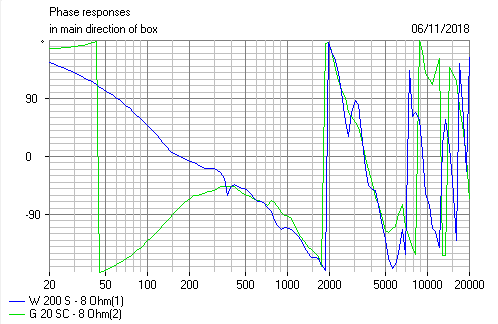
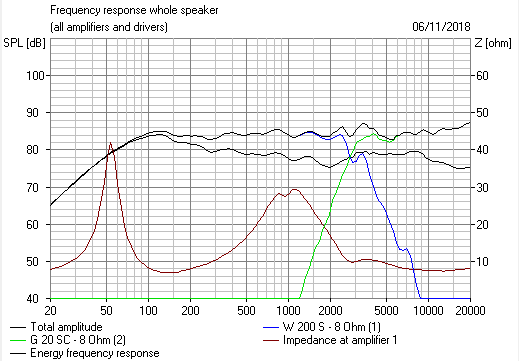
The filter, which is usually witheld, but I am an Open-Source sort of person:
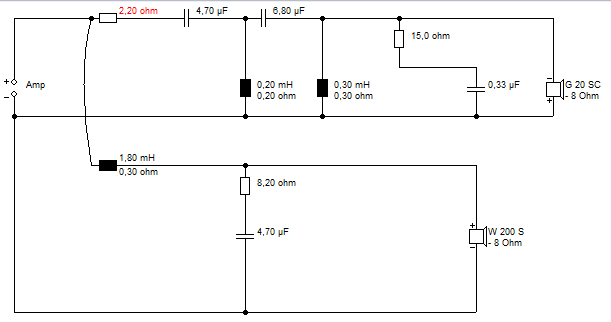
This is another classic 8" polycone from SEAS, and £41 makes it a bargain:
Seas P21RE/P H0942-08 Woofer. H0313 2015 remake
Phase plugs and polycones are very Harbeth. Maybe one of the secrets of unfatiguing sound. But, unusually these days, it is a closed box driver, Qts 0.51. So not quite what we want here, though you could stuff a big sock in the port.
Much to enjoy in Joachim Gerhard's musings on his Arkadia experiments.
Sonics by Joachim Gerhard cabinets and kits.
Your two tweeters should both work well above 3KHz. I want to know how this turns out! 😀
That Audax HM210CP looks alright. Though the peak at 4 kHz might be troublesome. The CSD or waterfall plot of stored energy shows the typical troublesome 3-4 kHz cone resonance, which IMO produces some 2nd harmonic nasties nearer 6kHz. You can always see this in the Phase plot too:
Proraum Vertriebs-GmbH | Shop | AUDAX Loudspeakers | AUDAX HM210CP
The filter, which is usually witheld, but I am an Open-Source sort of person:
This is another classic 8" polycone from SEAS, and £41 makes it a bargain:
Seas P21RE/P H0942-08 Woofer. H0313 2015 remake
Phase plugs and polycones are very Harbeth. Maybe one of the secrets of unfatiguing sound. But, unusually these days, it is a closed box driver, Qts 0.51. So not quite what we want here, though you could stuff a big sock in the port.
Much to enjoy in Joachim Gerhard's musings on his Arkadia experiments.
Sonics by Joachim Gerhard cabinets and kits.
Your two tweeters should both work well above 3KHz. I want to know how this turns out! 😀
Last edited:
The HM210CP is interesting, it would actually fit the existing recess so i wouldn't have to make a whole new front panel, then again the existing front isn't chamfered which is apparently 'a bad thing'. It does also have a bit of a peek at 4kHz, don't know how much i could mitigate that with a really steep digital crosover. I had briefly considered the seas metal cones but decided against them for the same reason, though the peeks were much sharper there
certainly lot's to think about here!
certainly lot's to think about here!
SEAS seem to make the most non-standard sizes of midwoofers. Most other brands keep quite strictly to values like 150mm chassis for 5" drivers.
I was interested that the Audax woofer has a very familiar form factor:
Proraum Vertriebs-GmbH | Shop | AUDAX Loudspeakers | AUDAX HM210CP
Actually identical chassis form and 217mm PCD mounting bolts to my old Elac paper bass Monitor Audio:
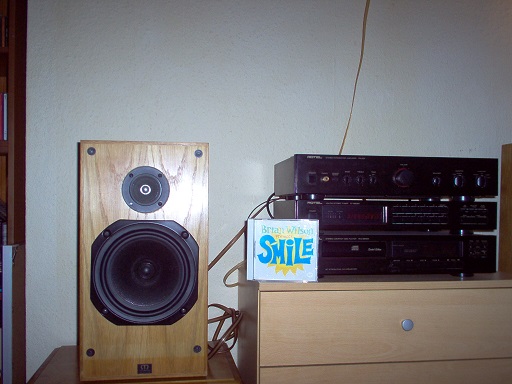
One of the things many designers look for in a driver is high Qms. This equates to low mechanical loss. The Audax comes in at 4.2. The SEAS at 1.77. The theory is high Qms speakers work well at low volume.
A lot of that is down to the Audax having a plastic Kapton voice-coil former. SEAS use aluminium formers which are split to (mostly) prevent eddy currents, which improves heat dissipation. Many old speakers just used a cardboard former.
All very debateable, but heavy cones certainly can sound dull, even if they measure very smooth.
I was interested that the Audax woofer has a very familiar form factor:
Proraum Vertriebs-GmbH | Shop | AUDAX Loudspeakers | AUDAX HM210CP
Actually identical chassis form and 217mm PCD mounting bolts to my old Elac paper bass Monitor Audio:
One of the things many designers look for in a driver is high Qms. This equates to low mechanical loss. The Audax comes in at 4.2. The SEAS at 1.77. The theory is high Qms speakers work well at low volume.
A lot of that is down to the Audax having a plastic Kapton voice-coil former. SEAS use aluminium formers which are split to (mostly) prevent eddy currents, which improves heat dissipation. Many old speakers just used a cardboard former.
All very debateable, but heavy cones certainly can sound dull, even if they measure very smooth.
This is fascinating. Feel a bit like i opened a can of bottomless pit in speaker design now haha.One of the things many designers look for in a driver is high Qms. This equates to low mechanical loss. The Audax comes in at 4.2. The SEAS at 1.77. The theory is high Qms speakers work well at low volume.
A lot of that is down to the Audax having a plastic Kapton voice-coil former. SEAS use aluminium formers which are split to (mostly) prevent eddy currents, which improves heat dissipation. Many old speakers just used a cardboard former.
These cabinets had previously been occupied by a pair of Audax HM210G0, which they shared with the previously mentioned seas tweeters. Results there were unspectacular. Could have been lots of reasons for that, the 210G0's have had a very hard life and are maybe a bit past it, i just don't like paper cones, the active crossover i had at the time had no way to adjust phase and match tweeter and woofer, the amp was a bit lackluster, whatever the reason they didn't work out.
The choice between a the u22 seas and hm210cp im left with now an interesting one, do i risk another audax? phase plug and carbon fiber of the 210cp is a very different thing to the paper cone of the original 210g0. higher breakup peak at 4khz possibly handy for a higher crossover. can't seem to find a waterfall graph for the seas to compare the audax against.
I would not compare hm210cp peak at 4k to seas alu resonances. Its amplitude a the rigde in waterfall are very mild. I think it will take only series RC in parallel to woofer coil to suppress it. Capacitor the tenths of uF and resistor.
Actually almost same peak is also in U22 response. In both cases, Though I would prefer it was not there, I think that peak would be hardly audible.
Actually almost same peak is also in U22 response. In both cases, Though I would prefer it was not there, I think that peak would be hardly audible.
This is fascinating. Feel a bit like i opened a can of bottomless pit in speaker design now haha.
These cabinets had previously been occupied by a pair of Audax HM210G0, which they shared with the previously mentioned seas tweeters. Results there were unspectacular. Could have been lots of reasons for that, the 210G0's have had a very hard life and are maybe a bit past it, i just don't like paper cones, the active crossover i had at the time had no way to adjust phase and match tweeter and woofer, the amp was a bit lackluster, whatever the reason they didn't work out.
The choice between a the U22 seas and HM210cp im left with now an interesting one, do i risk another audax? phase plug and carbon fiber of the 210cp is a very different thing to the paper cone of the original 210g0. higher breakup peak at 4khz possibly handy for a higher crossover. can't seem to find a waterfall graph for the seas to compare the audax against.
I would not compare hm210cp peak at 4k to seas alu resonances. Its amplitude a the rigde in waterfall are very mild. I think it will take only series RC in parallel to woofer coil to suppress it. Capacitor the tenths of uF and resistor.
Actually almost same peak is also in U22 response. In both cases, Though I would prefer it was not there, I think that peak would be hardly audible.
I've been mulling this over. And 8" plus 1" (or 2" cone tweeters...) speakers are a bit of a hobby-horse of mine!
I think a smooth 8" driver is the key to an easy build. Sure you can notch a peak with a passive crossover, and I have tried some tank notches, but why bother? And you won't do that with an active filter.
How it works is you don't actually do much to an 8" driver, filter-wise. The electrical response with 8" is actually only first to second order. Maybe 9dB/octave. The tweeter can get much steeper electrically, even 24dB/octave. Active filters are not something I have experience with, but some sort of bafflestep is probably needed unless you mount close to the wall.
Troels Gravesen tried a roughish Scan 8" here. A nasty peak around 8dB and 3.5kHz. Even with a low 1.7kHz crossover, it didn't go away. And this is not just a peak, it is harsh cone breakup and distortion.
8555-7100
He did something after my own heart with the TQWT here. A 3.2kHz crossover that still managed to work well. The notch was a bit higher, possibly optional, but more of a nudge in the right direction rather than an exact correction.
TQWT-
This speaker is mostly time-aligned, so positive polarity, which is not going to happen with the current sigmatechnica cabinet.
My overall feeling is the SEAS U22 is going to be plain easier than the Audax. It may be that you could try the original old Audax G0 driver again, too. Based on a better understanding. It looks very well behaved from my searches.
Last edited:
I can time align with a digital crossover ( Pulseaudio Crossover Rack :: T5! DIY Audio Software & Hardware ), and was planning on doing so, though how i tune it is an open question since i have no way to measure.This speaker is mostly time-aligned, so positive polarity, which is not going to happen with the current sigmatechnica cabinet.
My overall feeling is the SEAS U22 is going to be plain easier than the Audax. It may be that you could try the original old Audax G0 driver again, too. Based on a better understanding. It looks very well behaved from my searches.
You are probably right there. I am leaning that way. It is unfortunate that the seas and the audax have incompatible mounting flanges. I have to decide on one to send off the design to the CNC place to make me a new front plate. unfortunately the G0s i already have are a bit tired. creases in the cones near the surround, i had to glue the voice coil former back to the suspension when i got them too 😀. I got them for free, can't complain but don't want to reuse in something that is suppose to last me a while. Did consider attempting further repairs but that would change them significantly i suspect and i have no way to measure the results.
Nice waveguides on those TQWT. I'm tempted by waveguides but they are so hard to design. Not a possibility without measurement gear either. not unless i find someone who has produced a 3d cad file for a particular tweeter that i could turn out on the 3d printer and get that exact tweeter. Or go for the 27TBC/G.
Veneering of the cabinets to start soon! 😀
Ah, you like Linux too!
Pulseaudio Crossover Rack :: T5! DIY Audio Software & Hardware
Multichannel sound card, eh? New to me, but interesting. You always have an easier life in linux with hardware that has real linux support.
If you are having some cabinet modifications done, you can't go far wrong with the SEAS U22 IMO. That and a 104mm tweeter rebate must leave multiple options open, including different SEAS woofers. And the conventional 1" SEAS 27TBC/G, and Morel CAT 378 and SEAS DXT waveguide tweeters.
These sort of threads always make me think. I haven't been listening to so much music lately since I installed dome tweeters. I might have another bash at cone tweeters.
Very musical, IMO.

And planet10 is winning me over with these little Fostex FE83 and FF85 fullrangers, which he says double as excellent tweeters with a little cabinet behind:
Buy Fostex Full Range Drive Units and Co-Axial Units Online, UK
Well, I've seen that sort of thing before, in a Wharfedale Linton which crossed around 1.8kHz:
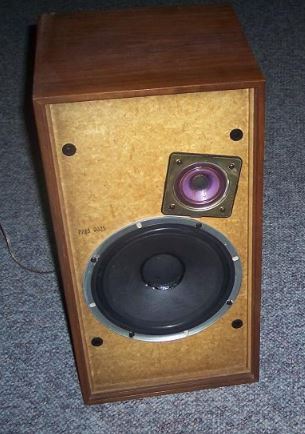
The tweeter just had a coffee-cup sized plastic enclosure behind it with a bit of stuffing in it! How hard is that? 😎
Pulseaudio Crossover Rack :: T5! DIY Audio Software & Hardware
Multichannel sound card, eh? New to me, but interesting. You always have an easier life in linux with hardware that has real linux support.
If you are having some cabinet modifications done, you can't go far wrong with the SEAS U22 IMO. That and a 104mm tweeter rebate must leave multiple options open, including different SEAS woofers. And the conventional 1" SEAS 27TBC/G, and Morel CAT 378 and SEAS DXT waveguide tweeters.
These sort of threads always make me think. I haven't been listening to so much music lately since I installed dome tweeters. I might have another bash at cone tweeters.
Very musical, IMO.
And planet10 is winning me over with these little Fostex FE83 and FF85 fullrangers, which he says double as excellent tweeters with a little cabinet behind:
Buy Fostex Full Range Drive Units and Co-Axial Units Online, UK
Well, I've seen that sort of thing before, in a Wharfedale Linton which crossed around 1.8kHz:
The tweeter just had a coffee-cup sized plastic enclosure behind it with a bit of stuffing in it! How hard is that? 😎
U22's ordered 😀
I had thought cone tweeters had gone away. I had some wharfedale melton 2's back in the day. 12" woofer and an odd purple ~2" tweeter much like that one in the linton. when i blew that up and couldn't find a replacement i made them into a 3 way with the 27TBC/G and L12RCY/p. It sounded fantastic, to my ears at the time anyway. more down to luck than anything else probably!
When these things are finished i'll be driving them with a custom amp i nearly have finished. 4 channels of ESP 101 mosfet amp kits (low power version) in the same box with an intel NUC motherboard, asus 'xonar' U5 soundcard and preamp/volume control. That pulse audio crossover will hopefully do an adequate job, it was a bit of a pain finding something that could cope with differing sample rate of source media/apps. maybe i should do a separate post about all that though, getting a bit OT for a speaker thread!
I had thought cone tweeters had gone away. I had some wharfedale melton 2's back in the day. 12" woofer and an odd purple ~2" tweeter much like that one in the linton. when i blew that up and couldn't find a replacement i made them into a 3 way with the 27TBC/G and L12RCY/p. It sounded fantastic, to my ears at the time anyway. more down to luck than anything else probably!
When these things are finished i'll be driving them with a custom amp i nearly have finished. 4 channels of ESP 101 mosfet amp kits (low power version) in the same box with an intel NUC motherboard, asus 'xonar' U5 soundcard and preamp/volume control. That pulse audio crossover will hopefully do an adequate job, it was a bit of a pain finding something that could cope with differing sample rate of source media/apps. maybe i should do a separate post about all that though, getting a bit OT for a speaker thread!
I used to have the Wharfedale Melton II as well.
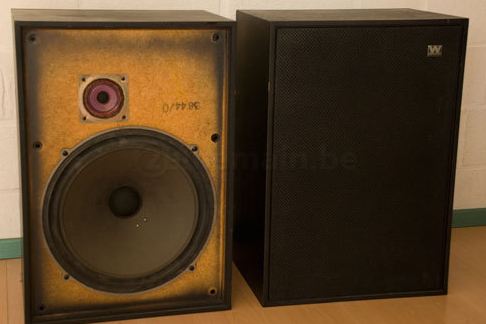
An alarming tendency for the purple plastic tweeter to blow up, as you also found. 😱
The, er, "Raison d'Etre" for the Melton is it exploited a tax break for loudspeakers in the UK back in the 70's.
Anything with a 12" bass or a three-way like the Spendor BC1 was considered "professional audio" and hence avoided 25% luxury purchase tax.
Hence the 12" £38 Melton was scarcely more expensive than the 8" £35 Linton. But had thunderous bass.

Onwards and Upwards, IMO. 😀
An alarming tendency for the purple plastic tweeter to blow up, as you also found. 😱
The, er, "Raison d'Etre" for the Melton is it exploited a tax break for loudspeakers in the UK back in the 70's.
Anything with a 12" bass or a three-way like the Spendor BC1 was considered "professional audio" and hence avoided 25% luxury purchase tax.
Hence the 12" £38 Melton was scarcely more expensive than the 8" £35 Linton. But had thunderous bass.
Onwards and Upwards, IMO. 😀
And after far too long waiting, the new front baffles have arrived!

Made from solid sapele to match the veneer that will be stuck to the sides while sporting a beveled edge. People get upset about using solid wood for speakers, bit they will be glued to the remains of the previous MDF baffle so I figure resonance wont be too much of a problem.
Now i have lots of gluing and veneering and sanding to do!
Made from solid sapele to match the veneer that will be stuck to the sides while sporting a beveled edge. People get upset about using solid wood for speakers, bit they will be glued to the remains of the previous MDF baffle so I figure resonance wont be too much of a problem.
Now i have lots of gluing and veneering and sanding to do!
Attachments
Sounds pretty good! Crossed around 2.1KHz with 24db crossover. Cabinets needed quite a bit of stuffing to get over some rather flabby bass, but that's likely more slightly sub-optimal design than any actual problem. Mids are quite presentable and the morel st1048 tweeters do a good job and seem a good match. All in all, not quite as good as a 3 way but not far off! probably someone who really knew what they were doing could do an even better job
- Home
- Loudspeakers
- Multi-Way
- Seas U22REX/P-SL any good in a ported 2way
